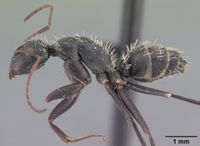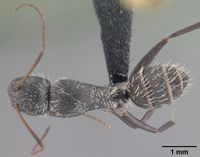Camponotus madagascarensis
| Camponotus madagascarensis | |
|---|---|

| |
| Scientific classification | |
| Kingdom: | Animalia |
| Phylum: | Arthropoda |
| Class: | Insecta |
| Order: | Hymenoptera |
| Family: | Formicidae |
| Subfamily: | Formicinae |
| Tribe: | Camponotini |
| Genus: | Camponotus |
| Subgenus: | Mayria |
| Species group: | madagascarensis |
| Species: | C. madagascarensis |
| Binomial name | |
| Camponotus madagascarensis Forel, 1886 | |
Camponotus madagascarensis is an endemic, widespread species of Madagascar. It is known to occupy western dry forest habitats, the north central and south central portions of eastern rainforests, savannah woodland of the central highland, and subhumid gallery forests of the southern high plateau. The species is absent from spiny bush and thicket in the southwest and southernmost portions of the island. The species is sympatric with Camponotus grandidieri, Camponotus mita and Camponotus voeltzkowii. Workers of C. madagascarensis forage either terrestrially on the forest floor, through leaf mold and rotten wood, or on low vegetation. Nests are constructed not only under rocks and rootmats and litter on rocks or rotten logs, and in the ground, but also in dead tree stumps, dead branches, and twigs above the ground (Rakotonirina, Csosz & Fisher, 2017).
Identification
A member of the Camponotus niveosetosus species group.
Rakotonirina et al. (2017) - Body color black; posterior portion of head, mesosoma dorsum, and lateral margin of propodeal declivity with randomly scattered, whitish, erect hairs; with head in full-face view, erect hairs lacking immediately behind lateral margin of clypeus, whitish erect hairs on posterior cephalic portion scattered laterally to level of anterior margin of eyes, median clypeal carina visible, eyes located in posterior fourth of head; in lateral view, mesosoma long and low; propodeal dorsum longer than declivitous face; numerous whitish erect hairs present on dorsum of body; petiolar node with two rows of hairs from its upper half to apex; transverse light strip on posterior margin of abdominal tergites large, width 1/5 the visible width of tergite.
Similar to Camponotus descarpentriesi, see the identification section of C. descarpentriesi for diagnostic details.
Keys including this Species
Distribution
Latitudinal Distribution Pattern
Latitudinal Range: -12.33333° to -24.24067°.
| North Temperate |
North Subtropical |
Tropical | South Subtropical |
South Temperate |
- Source: AntMaps
Distribution based on Regional Taxon Lists
Malagasy Region: Madagascar (type locality).
Distribution based on AntMaps
Distribution based on AntWeb specimens
Check data from AntWeb
Countries Occupied
| Number of countries occupied by this species based on AntWiki Regional Taxon Lists. In general, fewer countries occupied indicates a narrower range, while more countries indicates a more widespread species. |

|
Estimated Abundance
| Relative abundance based on number of AntMaps records per species (this species within the purple bar). Fewer records (to the left) indicates a less abundant/encountered species while more records (to the right) indicates more abundant/encountered species. |

|
Biology
Castes
Queen
Images from AntWeb
   
| |
| Queen (alate/dealate). Specimen code casent0101207. Photographer April Nobile, uploaded by California Academy of Sciences. | Owned by NHMB, Basel, Switzerland. |
Nomenclature
The following information is derived from Barry Bolton's Online Catalogue of the Ants of the World.
- madagascarensis. Camponotus niveosetosus r. madagascarensis Forel, 1886c: civ (w.) MADAGASCAR.
- [Camponotus niveosetosus var. madagascarensis Forel, 1879a: 115. Nomen nudum.]
- [Misspelled as madagascariensis by Forel, 1891b: 42; Emery, 1925b: 129, and others.]
- Santschi, 1926b: 262 (q.); Rakotonirina, et al. 2017: 235 (s.).
- Combination in C. (Myrmopiromis): Wheeler, W.M. 1922a: 1052.
- Subspecies of niveosetosus: Forel, 1891b: 42 (redescription); Dalla Torre, 1893: 245; Emery, 1896d: 377 (in list); Forel, 1907e: 14; Wheeler, W.M. 1922a: 1052; Emery, 1925b: 129; Bolton, 1995b: 110 (error).
- Status as species: Santschi, 1926b: 262; Rakotonirina, et al. 2017: 233 (redescription).
Unless otherwise noted the text for the remainder of this section is reported from the publication that includes the original description.
Description
Worker
Rakotonirina et al. (2017) – Minor In full-face view head elongate and rectangular (CWb/CL: 0.76–0.89), lateral border straight and slightly diverging posteriorly and joining the more or less convex posterior margin in a rounded angle. Eyes protruding, located at posterior fourth of head (PoOC/CL: 0.24±0.02; 0.21–0.27) and occasionally breaking lateral outlines of head (CWb/CL: 0.76–0.89; CW/CL: 0.78–1.05). Clypeus truncate anteriorly, with bluntly rounded anterolateral angle; longitudinally median, blunt carina present; posterior margin feebly notched medially. Mandible subtriangular, apical margins with six teeth. Antennal scape long, its distal portion extending beyond posterior margin of head. In lateral view, mesosoma long and low (MPH/ML: 0.41±0.03, 0.35–0.47), with broadly convex dorsal outline, distinctly decreasing in height toward posteriormost portion of the straight propodeal dorsum. In dorsal view, metanotal groove obsolete, slightly impressed or characterized by a simple shiny line. Propodeal declivity slightly inclined posteriorly and somewhat concave toward junction to petiolar node. Propodeal spiracle opening elongate or slitlike. Petiolar node scalelike, anterior and posterior faces parallel to each other from base to upper half from level of spiracle and then anterior face posteriorly inclined to reach the dorsalmost portion of posterior margin. Tibial spurs of middle and hind legs pectinate. Transverse light strip on posterior margin of gastral tergites wide, maximum width roughly 1/5 of the visible width of second tergite.
Head and mesosoma finely and densely reticulate punctate. Gastral tergites finely coriarious or finely strigulate. Mandible imbricate with sparse piligerous punctures. Numerous whitish erect hairs randomly scattered along median portion to posterior fifth portion of head, where they are transversally scattered to the lateral cephalic margin down to the level of compound eyes; erect hairs absent immediately behind lateral clypeal margin. Hairs on anteromedian portion of head and gastral sternites thinner than those from near posterior cephalic margin to gastral tergites. Some hairs on petiolar node and posterior portion of propodeum at least twice as long as those on promesonotum. Pubescence on dorsum of body sparse, but denser on gastral tergites. Body color black and matte; legs basally reddish black to reddish brown, tarsus and antennal scape yellowish brown, and funiculus dark brown.
Major Characteristics of minor worker, except: head much larger (CS: 2.44±0.24, 2.05–2.76; CWb/ CL: 0.89±0.03, 0.86–0.95); lateral margins either broadly convex or straight and abruptly converging towards base of mandibles. Mandibles more robust, apical margin more elongate and armed with seven to eight teeth. Median portion of clypeus elongate (ClyL/GPD: 0.89±0.04, 0.81–0.95; ClyL/CL: 0.32±0.00, 0.32–0.33), with more rounded anterolateral angle and more flat median portion. Eyes located more in front of head capsule (CWb/CL: 0.89±0.03, 0.86–0.95; CW/CL: 0.78±0.02, 0.75–0.82), level of their posterior margin at posterior third of head capsule (PoOc/CL: 0.30±0.01, 0.29–0.32). Antennal scape barely surpassing posterior cephalic margin. In dorsal view, metanotal groove impressed; metanotum not visible; in lateral view, propodeum feebly at lower level with respect to promesonotum. In lateral view, petiolar node higher and more flattened anteroposteriorly. Head capsule finely and densely reticulate punctate; sparse appressed hair arises from middle of two to five smaller punctures embedded in one larger puncture on lateral portion.
Type Material
- Lectotype (designated by Rakotonirina, Csosz & Fisher, 2017: 233), minor worker, unspecified locality, Madagascar, Grandidier, CASENT010383, Musee d'Histoire Naturelle Genève.
References
- Bolton, B. 1995b. A new general catalogue of the ants of the world. Cambridge, Mass.: Harvard University Press, 504 pp. (page 110, catalogue)
- Forel, A. 1886c. Diagnoses provisoires de quelques espèces nouvelles de fourmis de Madagascar, récoltées par M. Grandidier. Ann. Soc. Entomol. Belg. 30:ci-cvii. (page civ, worker described)
- Rakotonirina, J.C., Csosz, S., Fisher, B.L. 2017. Taxonomic revision of the Malagasy Camponotus grandidieri and niveosetosus species groups (Hymenoptera, Formicidae) using qualitative and quantitative morphology. Zootaxa 4238: 203–245 (doi:10.11646/zootaxa.4238.2.2).
- Rasoamanana, N., Fisher, B.L. 2022. A taxonomic revision of the Malagasy endemic subgenus Mayria of the genus Camponotus (Hymenoptera, Formicidae) based on qualitative morphology and quantitative morphometric analyses. ZooKeys 1081: 137–231 (doi:10.3897/zookeys.1081.71872).
- Santschi, F. 1926b. Description de nouveaux Formicides éthiopiens (IIIme partie). Rev. Zool. Afr. (Bruss.) 13: 207-267 (page 262, queen described)
- Wheeler, W. M. 1922k. Ants of the American Museum Congo expedition. A contribution to the myrmecology of Africa. IX. A synonymic list of the ants of the Malagasy region. Bull. Am. Mus. Nat. Hist. 4 45: 1005-1055 (page 1052, Combination in C. (Myrmopiromis))
References based on Global Ant Biodiversity Informatics
- Fisher B. L. 1997. Biogeography and ecology of the ant fauna of Madagascar (Hymenoptera: Formicidae). Journal of Natural History 31: 269-302.
- Fisher B. L. 2003. Formicidae, ants. Pp. 811-819 in: Goodman, S. M.; Benstead, J. P. (eds.) 2003. The natural history of Madagascar. Chicago: University of Chicago Press, xxi + 1709 pp.
- Forel A. 1886. Diagnoses provisoires de quelques espèces nouvelles de fourmis de Madagascar, récoltées par M. Grandidier. Annales de la Société Entomologique de Belgique. 30: ci-cvii.
- Forel A. 1897. Ameisen aus Nossi-Bé, Majunga, Juan de Nova (Madagaskar), den Aldabra-Inseln und Sansibar, gesammelt von Herrn Dr. A. Voeltzkow aus Berlin. Mit einem Anhang über die von Herrn Privatdocenten Dr. A. Brauer in Marburg auf den Seychellen und von Herrn Perrot auf Ste. Marie (Madagaskar) gesammelten Ameisen. Abhandlungen der Senckenbergischen Naturforschenden Gesellschaft 21: 185-208.
- Forel A. 1907. Formiciden aus dem Naturhistorischen Museum in Hamburg. II. Teil. Neueingänge seit 1900. Mitt. Naturhist. Mus. Hambg. 24: 1-20.
- Ravelomanana A., and B. L. Fisher. 2013. Diversity of ants in burned and unburned grassland , and dry deciduous forest in the Beanka Reserve, Melaky Region, western Madagascar. Malagasy Nature 7: 171-183.
- Wheeler W. M. 1922. Ants of the American Museum Congo expedition. A contribution to the myrmecology of Africa. IX. A synonymic list of the ants of the Malagasy region. Bulletin of the American Museum of Natural History 45: 1005-1055

